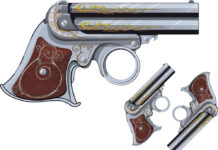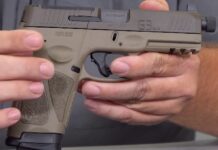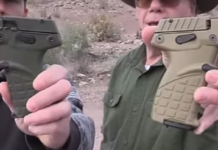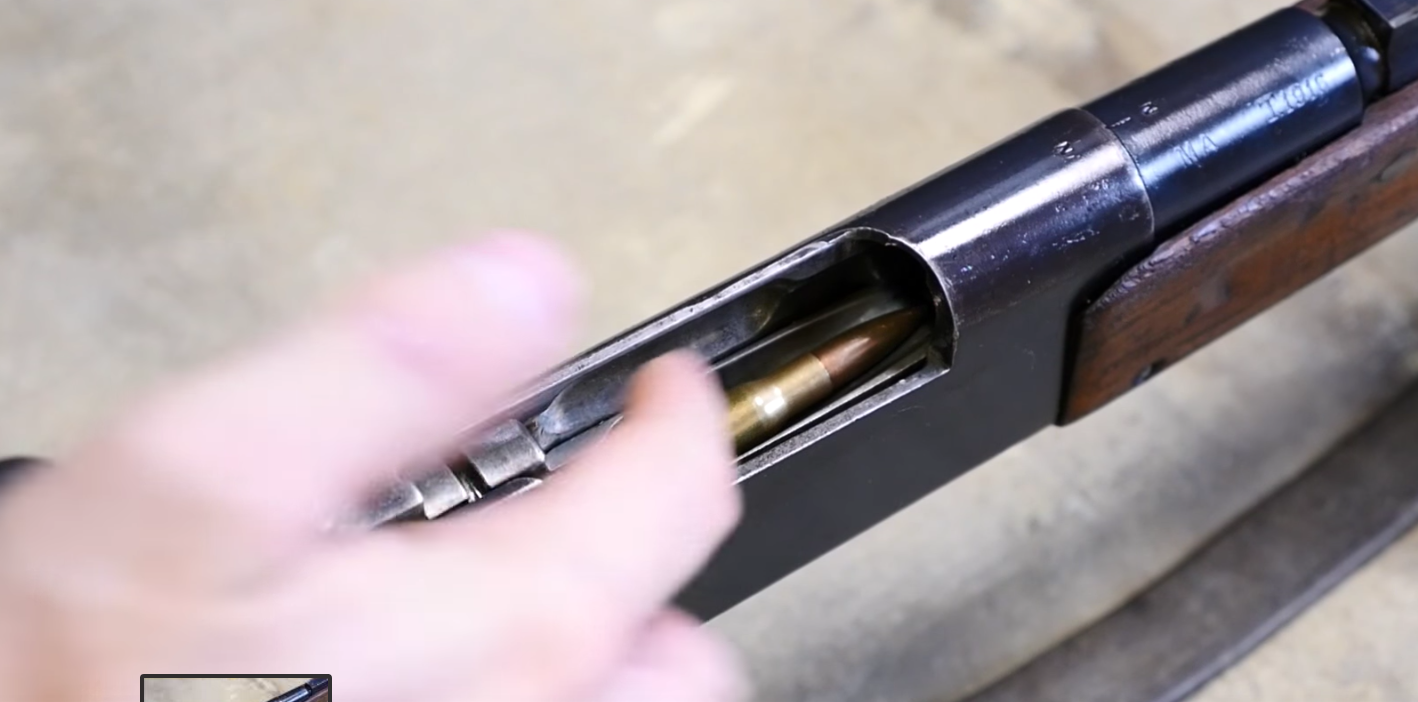Firearms technology steadily moves forward as each day goes by. Today we’re lucky enough to witness the development of the most powerful and accurate firearms ever made. But do you ever wonder what came before them?
Sure, you probably know about some of the classic, iconic rifles of history, but do you know which firearms changed the world forever?
There are a handful of guns that set a new standard for their time, and they’re fascinating to see in action.
Advertisement
Check out the video below to see what we mean.
What do you think? Are there any other rifles that should be on this list?
Tell us in the comments.
Advertisement










![What Level Holster Should You Be Using? [Video]](/wp-content/uploads/2024/04/Depositphotos_44548439_S-218x150.jpg)
![Case Study: Defensive Gun Use [Video] NSFW](/wp-content/uploads/2025/07/Depositphotos_282075792_S-218x150.jpg)




















![Optic Ready vs Milled slides? [Video]](/wp-content/uploads/2024/02/image-3-100x70.png)
![[Checklist] What Gear You Need To Take Pistol, Rifle & Shotgun Training Courses [Video]](/wp-content/uploads/2023/07/Depositphotos_275087632_L-100x70.jpg)
![What is in Carter’s 2023 EDC? [Video]](/wp-content/uploads/2023/07/Depositphotos_146856137_L-100x70.jpg)



Excellent choices. My personal favorite rifle is a Swiss SKS. When ya absolutely want to hit the V ring (or organic target) at 1-2 clicks, the SKS gets it done. Thanks for the video. Well done.
The title was “the 5 rifles that changed to world”—Yet where is the lever-action that changed America? I do not disagree with any of the choices, except there should be a place for the first modern repeater. Take your pick—Henry or Yellowboy or ’73. The lever action design was fully as revolutionary in its time as the semi-auto in its time.
I’m with you Carl!
I agree with your choices, but I would have included the leaver action carbine “The rifle that won the West”. One thing it allowed that no other rifle did was it’s easy operation from horseback. And, if you don’t think that was a military operation, look again at your history in this country.
So, which of your five would I jettison? None, as I see the the French 1886 rifle and the Mauser as part on one continuous evolution. But, I would have taken that evolution farther than you did. Look at how that Mauser bolt action was the basic design of the Winchester Model 70 – pre-64 rifles. “OH, but that was a hunting rifle!” Indeed it was, but they were THE hands down favorite choice for all US trained snipers through and past the Vietnam War. Hummmm … I wonder why?
I’m with Carl. I was disappointed that there was no mention of the original American repeating rifle. The lever action rifle. Load on Sunday,and shoot all week. It became popular around the mid 19th century, and is still popular today, 150+ years later.
‘
L1A1
Three problems:
#1. No mention of the *rifle* part of long guns, when the spiral grooves provided individual target accuracy, instead of smooth bore musket that was only accurate at close range in volley fire against massed opponent formations.
#2, Background of the AK. Soviets in 1930s saw war with Germany coming. USSR had very limited manufacturing capacity, vast manpower resources. Moisan Nagant was a good bolt action battle rifle left over from World War One, comparable to Mauser, Springfield etc. But Soviets knew providing that rifle to and teaching long range rifle marksmanship to huge numbers of recruits (many of whom did not even speak Russian) would be a burden. They decided to concentrate scarce manufacturing resources on artillery, tank guns and Infantry machine guns, and equip the main body of troops with short range, pistol cartridge, full auto sub-machine guns, the culmination of which was PPSh 41. Massed Infantry formations charging into enemy positions to *clean out the trenches* with full auto SMG fire. The AK family is simply an upgrade (still basically a pistol cartridge) of that approach. Underpowered for a battle cartridge. Vast numbers of soldiers who were shot by AK are alive today, simply because they were shot with an AK. As to widespread adoption, consider the source. Virtually all of the nations/armies who are now armed with AK were given those arms by Soviet or ChiCom efforts at world revolution and world domination. None of them did an independent test and evaluation of *all other available Infantry rifles* and selected the AK as best – – only adopted because they thought it was free. (Accepting gifts from Communists always had dangerous strings attached.) AK action is wonderfully durable and reliable, just underpowered for a battle rifle. Same action in 7.62 NATO (sold in the West as semi-auto only) is a great piece of gear.
#3. AR-15 was a Hail Mary by Colt about to go bankrupt, sold to Air Force for base security Air Police as a con job by bursting watermelons for Curtis LeMay, then blindly adopted by Army as a pig in a poke/keeping up with the Jones (Air Force has it we gotta get it) for issue to *smaller framed Vietnamese* by mistake. The Vietnamese Rangers I advised in 1964/65 (average size 5’2″ in height, 110 pounds soaking wet) were armed with Thompson SMG in .45 ACP, M-1 Garand rifles, BAR and M1919A4 or A6 all in .30-06 and they never complained, ever, about weight of those weapons or ammo, but were thrilled that they could kill Communists with those arms. So then after an even more devious sales campaign by COLT, the US Army adopted it without even remotely adequate test and evaluation.
AR-15/M-16 in 5.56 mm or .223 caliber is sending a boy to do a man’s job. That is a varmint cartridge, pure and simple, good for gophers and rabbits. Not legal for deer hunting in many states. Will not bust brush, easily deflected by even thick grass, bullet explodes on contact with twigs and other small branches, utterly useless in jungle and I could go on and on. But it was a political decision – – bail out Colt, keep up with Air Force, look good doing something innovative and never admit any mistakes – – put that together with the Johnson/McNamara debacle of National military policy and the A%-15/M-16 became the crazy uncle locked in the attic that no General would ever admit as a disaster/failure/dumbass mistake. (Commandant of Marine Corps stated anyone who bad mouths M-16 might as well have current rank tattooed on collarbone because that Marine will never be promoted again, or words to that effect).
For a more complete exposure of that debacle see this superb analysis
http://www.americanthinker.com/articles/2004/08/the_last_big_lie_of_vietnam_ki.html
US Troops’ experience in the Sandbox and the Afghan has confirmed that the puny projo will not accomplish the mission, so they have dug out of storage M-14s, with 7.62 NATO battle capable cartridge, for issue to some rifle squad members.
All the info above is based on fifty years intimate association with and study of Military History, rifles, rifle cartridges and Infantry tactics, to include 25 years in the Army, as a with 49 months Infantry combat time in Viet-Nam (commanded three rifle companies and a recon company).
Oh, yer breaking my heart! I shot a 4 inch group at 300 meters with 10 rounds of standard ball ammo with my standard issue M16 back in ’74. Thing shot straight. You have to give it that, although I do hear you about not packing the punch and penetration that the .308 and .30-06 have. Maybe rechambered for the .243 it might be a good compromise. One thing about .223, though, pound for pound you get more rounds.
Agree with Lewis 100%. My uncle was a Path Finder and served as a adviser in Vietnam in early 60s, back when there were still French Legionnaires there and they were using M14 and FAL, but all .308. And AK-47 mass produced, loose low tolerance. There is a reason full auto is 1 position down from safe, most push all the way down and start shooting. But it is a Iconic weapon that has a place in history even though part of design can be traced to German Sturmgewehr 44 and Kurz cartridge, the use of stampings. Which German Engineers took to Spain and came back to HK as CETME and the roller delayed action has had plenty of use.
Interesting video; thank-you. Additionally, thank-you the rest of you all for taking the time to write some exceptionally great, well thought comments. Before I watched the video, I jotted down a quick list of the weapons I thought would be illustrated, and the M-1 Garand, M-16, and AK-47 were on my list. For grins, my list included the Springfield 1901, M-2 .50 caliber MG, and Russian SVD sniper rifle.
Speaking from the standpoint of a career enlisted/commissioned infantryman (1973-1996), I can only comment from my experience. From the onset, I thought that the M-16 was a piece of junk, demanding far too much maintenance to keep operational than other designs. Why the US did not equip its fighting personnel with a weapon having similar operations as the M-1, M-14, etc., is beyond me. They were such simple and trustworthy machines. I wish the mini-14 type of operation would have been adopted if weight was a consideration. The selection of the M-16 over other models has a political stench hovering over it.
The AK-47 is also a piece of junk when it comes to accuracy. But, like the M-16, it seems to be easily mass produced for sales to other countries. Indeed, it is simple, trustworthy, and is capable of shoving a massive wall of lead towards an enemy, but it’s limitation demands it be employed in close-in fighting situations.
I thought for certain the M-2, .50 caliber MG would have been included. I have never seen such a reliable and accurate piece of art in my life, and I loved everything about it, with one exception. It was heavy! I wish someone had considered making a scaled down version of it rather than giving us the M-60 MG, which to me was another piece of junk that required too much maintenance to remain reliable.
Well, that is all this infantryman and Ranger Battalion veteran is able to remember from 20 years ago. Thank-you again for the video, and thank-you to the rest of you all for your fascinating comments.
I’d have begun with Pennsylvania and Kentucky long rifles. then the Spencer (“load on Sunday and shoot all week”), then the Mauser, then the AK, then the M16. But I see and have to admit the one’s you picked were probably the most influential. I have a model 98 that was built in ’95 and sold to Chili. SN 2242. It was so old, you could mail it when I got it. It had been rebored by Chili to .308 so it must have initially been a 7mm, I figure. ARs are too pricey for me, but I couldn’t resist the 98 dollar SKS that once degreased and taken to the range, with cheapo Russian surplus steel cased ammo fired a minus 1.5 inch group at one hundred yards with its first three shots an inch above the bull and with no sight adjustment. Out of the box, ready for war. Don’t like the sights on the SKS in the woods, though. Out in the sunlight they are fine, but in the woods, can’t see ’em at all, although the Ott Six Springfield military sights were visible in the woods as was the M16 sight.
Comments are closed.